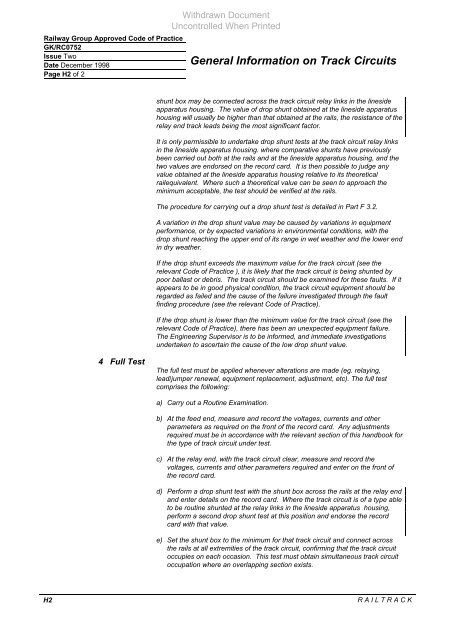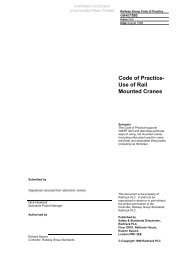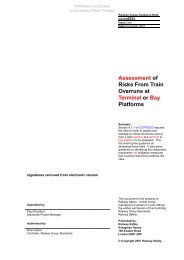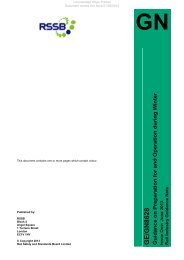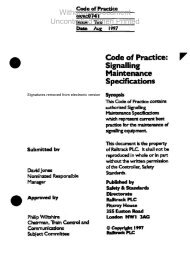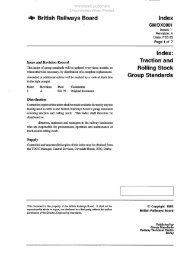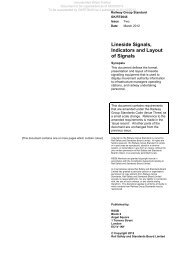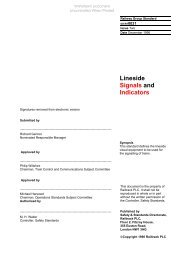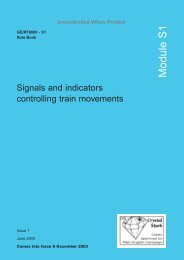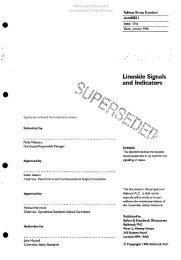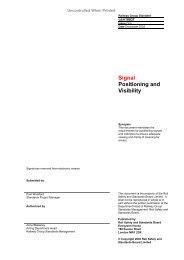General Information on Track Circuits - RGS Online
General Information on Track Circuits - RGS Online
General Information on Track Circuits - RGS Online
Create successful ePaper yourself
Turn your PDF publications into a flip-book with our unique Google optimized e-Paper software.
Railway Group Approved Code of Practice<br />
GK/RC0752<br />
Issue Two<br />
Date December 1998<br />
Page H2 of 2<br />
4 Full Test<br />
Withdrawn Document<br />
Unc<strong>on</strong>trolled When Printed<br />
<str<strong>on</strong>g>General</str<strong>on</strong>g> <str<strong>on</strong>g>Informati<strong>on</strong></str<strong>on</strong>g> <strong>on</strong> <strong>Track</strong> <strong>Circuits</strong><br />
shunt box may be c<strong>on</strong>nected across the track circuit relay links in the lineside<br />
apparatus housing. The value of drop shunt obtained at the lineside apparatus<br />
housing will usually be higher than that obtained at the rails, the resistance of the<br />
relay end track leads being the most significant factor.<br />
It is <strong>on</strong>ly permissible to undertake drop shunt tests at the track circuit relay links<br />
in the lineside apparatus housing. where comparative shunts have previously<br />
been carried out both at the rails and at the lineside apparatus housing, and the<br />
two values are endorsed <strong>on</strong> the record card. It is then possible to judge any<br />
value obtained at the lineside apparatus housing relative to its theoretical<br />
railequivalent. Where such a theoretical value can be seen to approach the<br />
minimum acceptable, the test should be verified at the rails.<br />
The procedure for carrying out a drop shunt test is detailed in Part F 3.2.<br />
A variati<strong>on</strong> in the drop shunt value may be caused by variati<strong>on</strong>s in equipment<br />
performance, or by expected variati<strong>on</strong>s in envir<strong>on</strong>mental c<strong>on</strong>diti<strong>on</strong>s, with the<br />
drop shunt reaching the upper end of its range in wet weather and the lower end<br />
in dry weather.<br />
If the drop shunt exceeds the maximum value for the track circuit (see the<br />
relevant Code of Practice ), it is likely that the track circuit is being shunted by<br />
poor ballast or debris. The track circuit should be examined for these faults. If it<br />
appears to be in good physical c<strong>on</strong>diti<strong>on</strong>, the track circuit equipment should be<br />
regarded as failed and the cause of the failure investigated through the fault<br />
finding procedure (see the relevant Code of Practice).<br />
If the drop shunt is lower than the minimum value for the track circuit (see the<br />
relevant Code of Practice), there has been an unexpected equipment failure.<br />
The Engineering Supervisor is to be informed, and immediate investigati<strong>on</strong>s<br />
undertaken to ascertain the cause of the low drop shunt value.<br />
The full test must be applied whenever alterati<strong>on</strong>s are made (eg. relaying,<br />
lead/jumper renewal, equipment replacement, adjustment, etc). The full test<br />
comprises the following:<br />
a) Carry out a Routine Examinati<strong>on</strong>.<br />
b) At the feed end, measure and record the voltages, currents and other<br />
parameters as required <strong>on</strong> the fr<strong>on</strong>t of the record card. Any adjustments<br />
required must be in accordance with the relevant secti<strong>on</strong> of this handbook for<br />
the type of track circuit under test.<br />
c) At the relay end, with the track circuit clear, measure and record the<br />
voltages, currents and other parameters required and enter <strong>on</strong> the fr<strong>on</strong>t of<br />
the record card.<br />
d) Perform a drop shunt test with the shunt box across the rails at the relay end<br />
and enter details <strong>on</strong> the record card. Where the track circuit is of a type able<br />
to be routine shunted at the relay links in the lineside apparatus housing,<br />
perform a sec<strong>on</strong>d drop shunt test at this positi<strong>on</strong> and endorse the record<br />
card with that value.<br />
e) Set the shunt box to the minimum for that track circuit and c<strong>on</strong>nect across<br />
the rails at all extremities of the track circuit, c<strong>on</strong>firming that the track circuit<br />
occupies <strong>on</strong> each occasi<strong>on</strong>. This test must obtain simultaneous track circuit<br />
occupati<strong>on</strong> where an overlapping secti<strong>on</strong> exists.<br />
H2 R A I L T R A C K


